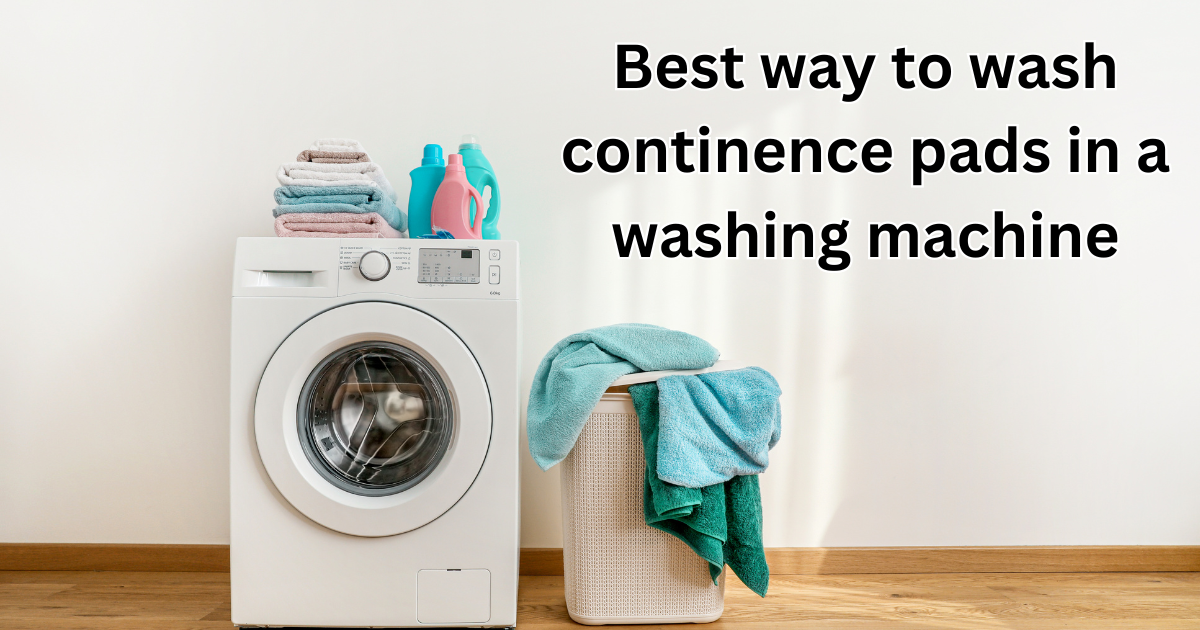Continence pads are essential for many individuals managing incontinence, providing comfort and confidence in daily life. Ensuring these pads are properly cleaned and maintained is crucial not only for hygiene but also for their longevity and effectiveness. Washing continence pads in a washing machine might seem straightforward, but there are specific practices that can optimize their care. This guide explores the best way to wash continence pads in a washing machine, covering everything from preparation to storage.
Introduction
Understanding Continence Pads
Continence pads are designed to absorb and contain urine, offering a practical solution for managing incontinence. They come in various sizes and absorbency levels, catering to different needs and preferences. Typically made from absorbent materials like fluff pulp and superabsorbent polymers, these pads provide comfort and protection. Given their role in maintaining hygiene and comfort, proper care is essential. Incorrect washing methods can affect their absorbency and overall effectiveness, making it crucial to follow best practices for cleaning.
Importance of Proper Washing
Proper washing of continence pads is vital for several reasons. Firstly, it ensures that the pads remain hygienic, free from bacteria and odors. Secondly, correct washing practices help preserve the integrity of the materials, extending the lifespan of the pads and maintaining their performance. Thirdly, it helps in avoiding any potential skin irritations or infections that could arise from improperly cleaned pads. By adhering to recommended washing practices, users can ensure that their continence pads remain effective, comfortable, and sanitary.
Choosing the Right Washing Machine
Front-Load vs. Top-Load Washing Machines
When it comes to washing continence pads, the type of washing machine can make a difference. Front-load washing machines are often preferred because they are gentler on fabrics due to their tumbling action and use less water. They also tend to have a more efficient spin cycle, which helps in reducing the drying time. Top-load machines, while effective, can be harsher on fabrics because of their agitator mechanism, which might cause wear and tear on the pads over time. For optimal results, a front-load machine is recommended, as it provides a more delicate yet thorough cleaning process.
Energy Efficiency Considerations
Energy-efficient washing machines are another consideration when choosing the right appliance for washing continence pads. These machines use less water and electricity, making them environmentally friendly and cost-effective in the long run. Energy-efficient models often come with features that optimize water usage and reduce wash times, which can be beneficial for maintaining the quality of continence pads. By investing in an energy-efficient washing machine, users can achieve excellent cleaning results while also contributing to environmental sustainability.
Preparing Continence Pads for Washing
Pre-Washing Tips
Before placing continence pads in the washing machine, it is essential to prepare them properly. First, rinse the pads in cold water to remove any excess urine. This step helps to prevent stains from setting and reduces the risk of odors. Additionally, pre-soaking the pads in a mixture of cold water and a mild detergent can help loosen any stubborn residues. By taking these pre-washing steps, users can ensure that their continence pads are thoroughly cleaned and ready for the washing machine, resulting in better overall hygiene.
Stain Removal Techniques
Stains on continence pads can be challenging to remove, but effective pre-treatment methods can help. One approach is to use a stain remover designed for delicate fabrics. Apply the stain remover to the affected areas and let it sit for 10-15 minutes before rinsing. For natural stain removal, a mixture of white vinegar and water can be used to pre-treat stains. Gently rub the mixture into the stain, allowing it to work before rinsing. These techniques help to address stains and ensure that the pads come out of the washing machine looking clean and fresh.
Selecting the Right Detergent
Importance of pH-Balanced Detergents
The choice of detergent plays a significant role in maintaining the quality of continence pads. pH-balanced detergents are recommended as they are formulated to be gentle on sensitive skin and fabrics. These detergents help maintain the natural pH balance of the pads, preventing irritation and preserving their absorbent properties. Using a pH-balanced detergent ensures that the pads are cleaned effectively without causing damage or degradation to the materials.
Avoiding Fabric Softeners and Bleach
Fabric softeners and bleach should be avoided when washing continence pads. Fabric softeners can leave a residue on the pads, reducing their absorbency and effectiveness. Bleach, on the other hand, can weaken the fibers and compromise the integrity of the pads. Instead, opt for a mild, hypoallergenic detergent that cleans without adding unnecessary chemicals. By avoiding these additives, users can maintain the quality and performance of their continence pads while ensuring a thorough clean.
Also Read: Insidious Proliferation of Marketing
Optimal Washing Machine Settings
Water Temperature Settings
Water temperature is a crucial factor in the best way to wash continence pads in a washing machine. It is generally recommended to use warm water for washing pads, as it helps to effectively remove stains and odors while being gentle on the fabric. Hot water can cause the materials to break down more quickly and may affect the absorbency of the pads. On the other hand, cold water might not be as effective in removing residues and stains. Warm water strikes a balance, ensuring a thorough clean without compromising the quality of the pads.
Spin Cycle Adjustments
Adjusting the spin cycle settings is another important consideration when washing continence pads. A moderate spin cycle is recommended to effectively remove excess water without causing damage to the pads. High spin speeds can lead to wear and tear, while low spin speeds may leave the pads too damp. By selecting a spin cycle that balances water removal and fabric care, users can achieve optimal results and ensure that the pads are adequately dried without unnecessary stress on the materials.
Washing Machine Maintenance
Cleaning the Drum
Regular maintenance of the washing machine drum is essential for ensuring that continence pads are cleaned effectively. Residual detergent, lint, and other debris can accumulate in the drum over time, leading to unpleasant odors and potential contamination. To keep the drum clean, run a maintenance cycle using a washing machine cleaner or a mixture of white vinegar and baking soda. This helps to remove buildup and maintain a hygienic environment for washing pads. Regular drum cleaning contributes to better washing results and prolongs the lifespan of the machine.
Regular Maintenance Checks
In addition to cleaning the drum, performing regular maintenance checks on the washing machine is crucial. Inspecting hoses, filters, and other components for signs of wear or damage can prevent issues that may affect washing performance. Ensuring that the machine is functioning correctly helps to avoid problems such as leaks, inefficient cleaning, or mechanical failures. By staying on top of maintenance, users can ensure that their washing machine remains in good working condition and continues to provide excellent results for washing continence pads.
Drying Continence Pads
Air Drying vs. Machine Drying
Choosing the right drying method for continence pads can impact their longevity and performance. Air drying is a gentle option that helps preserve the integrity of the pads, preventing potential heat damage. Simply hang the pads in a well-ventilated area to dry. Machine drying, while convenient, may expose the pads to high heat, which can affect their materials and absorbency. If machine drying is preferred, use a low heat setting to minimize the risk of damage. Both methods have their advantages, so choose based on your preferences and the specific needs of the pads.
Avoiding Heat Damage
Heat damage is a concern when drying continence pads, especially when using a tumble dryer. High temperatures can weaken the fibers, reduce absorbency, and affect the overall quality of the pads. To avoid heat damage, select a low or no-heat drying option if using a machine dryer. Alternatively, air drying is a safer choice that helps maintain the pads’ performance and longevity. By taking care to avoid excessive heat, users can ensure that their continence pads remain effective and comfortable.
Storing Washed Continence Pads
Proper Storage Conditions
Once continence pads are washed and dried, proper storage is essential for maintaining their cleanliness and effectiveness. Store the pads in a dry, cool place to prevent moisture buildup and bacterial growth. Avoid storing pads in areas with high humidity or direct sunlight, as these conditions can affect their quality. Using a clean, dry container or drawer for storage helps to keep the pads fresh and ready for use when needed. Proper storage practices contribute to the overall hygiene and longevity of continence pads.
Avoiding Bacterial Growth
To prevent bacterial growth, ensure that continence pads are completely dry before storing them. Moist environments can promote the growth of bacteria and mold, which can compromise the pads’ hygiene and effectiveness. Additionally, regular cleaning of storage containers and drawers is important to maintain a sanitary environment. By following these practices, users can keep their continence pads clean and ready for use, minimizing the risk of infections and maintaining optimal performance.
Common Mistakes to Avoid
Overloading the Washing Machine
Overloading the washing machine is a common mistake that can affect the cleaning process and the condition of continence pads. When it comes to the best way to wash continence pads in a washing machine, ensuring that the machine is not overloaded is crucial. When the machine is overloaded, the pads do not have enough space to move freely, resulting in inadequate cleaning and potential damage. This can lead to residue buildup, ineffective stain removal, and wear on the pads. To achieve the best results and ensure a thorough clean, it is essential to avoid overloading the machine and instead wash continence pads in smaller, manageable loads.
Using the Wrong Detergent
Using the wrong detergent can impact the effectiveness and longevity of continence pads. Harsh detergents or those with strong fragrances can cause irritation and reduce the absorbency of the pads. It is important to choose a mild, hypoallergenic detergent specifically designed for sensitive fabrics. This ensures that the pads are cleaned effectively without compromising their quality. By selecting the appropriate detergent, users can maintain the integrity and performance of their continence pads.
Conclusion
In summary, the best way to wash continence pads in a washing machine requires attention to detail to ensure optimal results. Start by preparing the pads properly, choosing the right washing machine and detergent, and setting the appropriate washing machine settings. Regular maintenance of the machine and proper drying and storage practices are also essential. By following these best practices, users can maintain the hygiene, effectiveness, and longevity of their continence pads.
Proper care of continence pads is crucial for maintaining their functionality and ensuring the comfort and well-being of users. By adhering to the best practices outlined in this guide, individuals can achieve excellent cleaning results and extend the lifespan of their pads. With the right approach, the best way to wash continence pads in a washing machine becomes a straightforward and effective process, contributing to overall health and quality of life.










